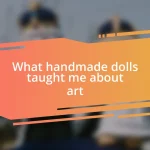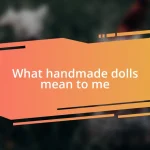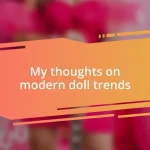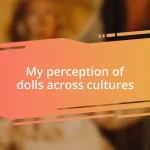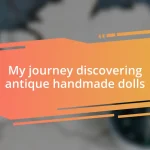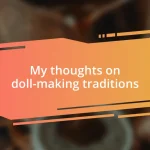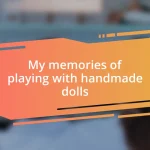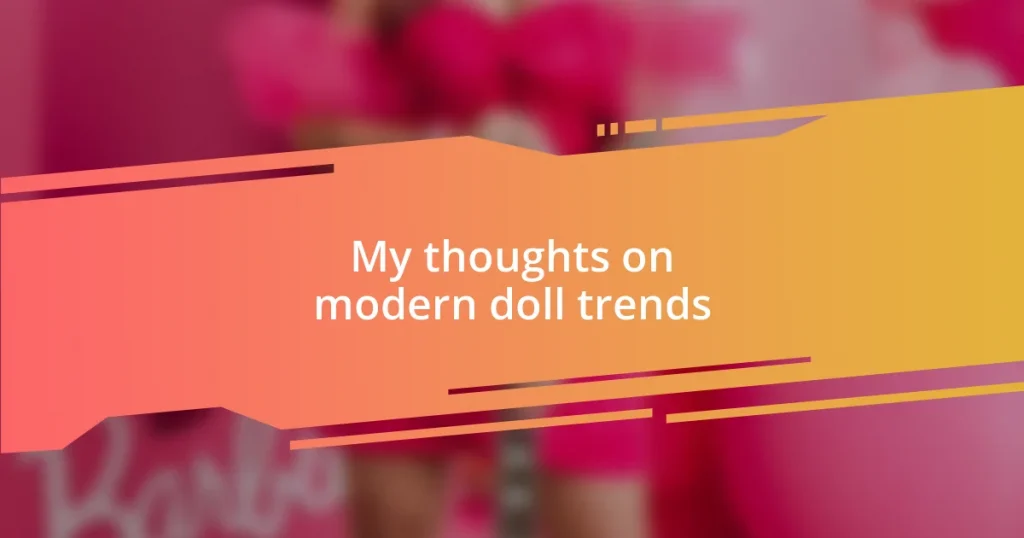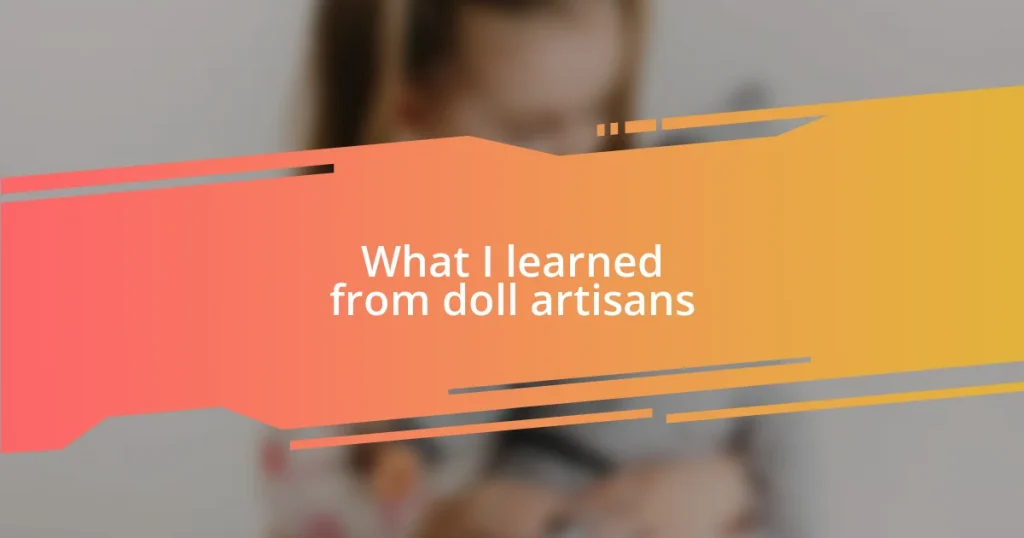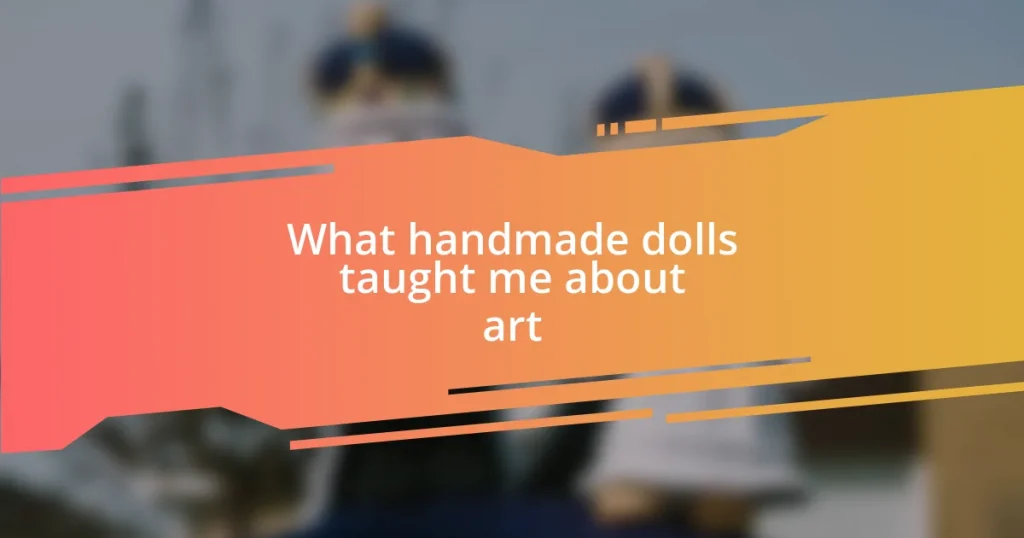Key takeaways:
- Modern dolls emphasize diversity, inclusivity, and representation, allowing children to see themselves and develop empathy towards different experiences.
- Technology enhances interactive play in dolls, introducing coding and augmented reality features that foster learning and creativity.
- There is a growing trend towards eco-friendly doll production, promoting sustainability while encouraging children to understand environmental responsibility.

Overview of modern doll trends
The landscape of modern doll trends has evolved dramatically, reflecting broader cultural shifts. I remember growing up with dolls that looked very much like me, but today’s dolls embrace a stunning array of diversity in body types, skin tones, and disabilities. Isn’t it fascinating how manufacturers now prioritize representation, allowing children to see themselves in their toys?
One of the most compelling trends I’ve observed is the rise of customization options. Parents and kids can now personalize dolls to reflect individual style and personality, deepening emotional connections. When my niece received a doll that resembled her favorite superhero, it sparked an exploration of creativity that I hadn’t anticipated. This kind of engagement is something I wish I had when I was younger!
Another notable trend is the incorporation of technology, with dolls that interact and even teach kids coding. I often wonder how different my childhood would have been with such innovations. The combination of interactive play and learning tools makes these modern dolls incredibly relevant, merging tradition with the future in a playful package.
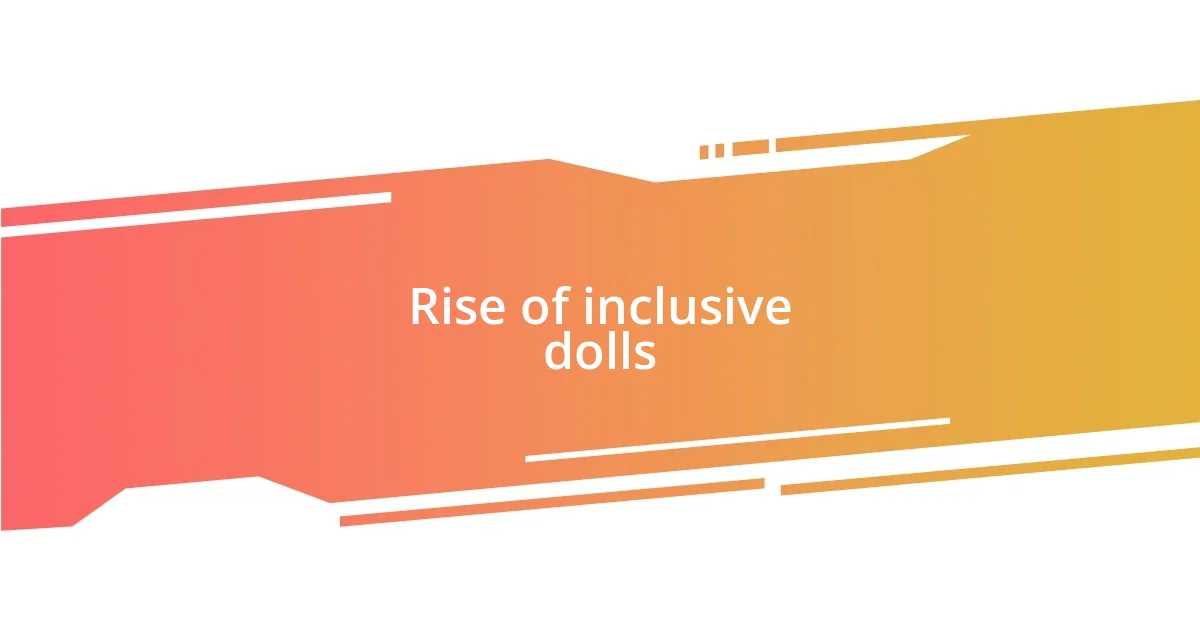
Rise of inclusive dolls
The rise of inclusive dolls marks a significant cultural evolution in the toy industry. When I first saw an inclusive doll with a different body type than the traditional ones, I felt an overwhelming sense of joy. It reminded me of how empowering it can be for children to see their uniqueness celebrated in the toys they play with.
What strikes me as particularly powerful is the representation of disabilities in dolls currently available on the market. I recall a conversation I had with a friend whose child uses a wheelchair; she mentioned how excited her daughter was to find a doll that mirrored her own experience. This connection fosters empathy, teaching kids the importance of inclusion from an early age.
Lastly, the marketing of inclusive dolls often involves communities sharing their stories, creating a sense of belonging. I once stumbled upon a social media campaign featuring real families and their experiences with diverse dolls. It reminded me of the broader conversations we should all engage in regarding representation and acceptance. This movement isn’t just about dolls; it’s about embracing our differences and celebrating what makes each of us unique.
| Trend | Description |
|---|---|
| Body Diversity | Dolls representing various body types challenge traditional beauty standards. |
| Disability Representation | Dolls inclusive of disabilities promote empathy and recognition of differences. |
| Community Engagement | Brands encourage sharing of personal stories to promote inclusion. |
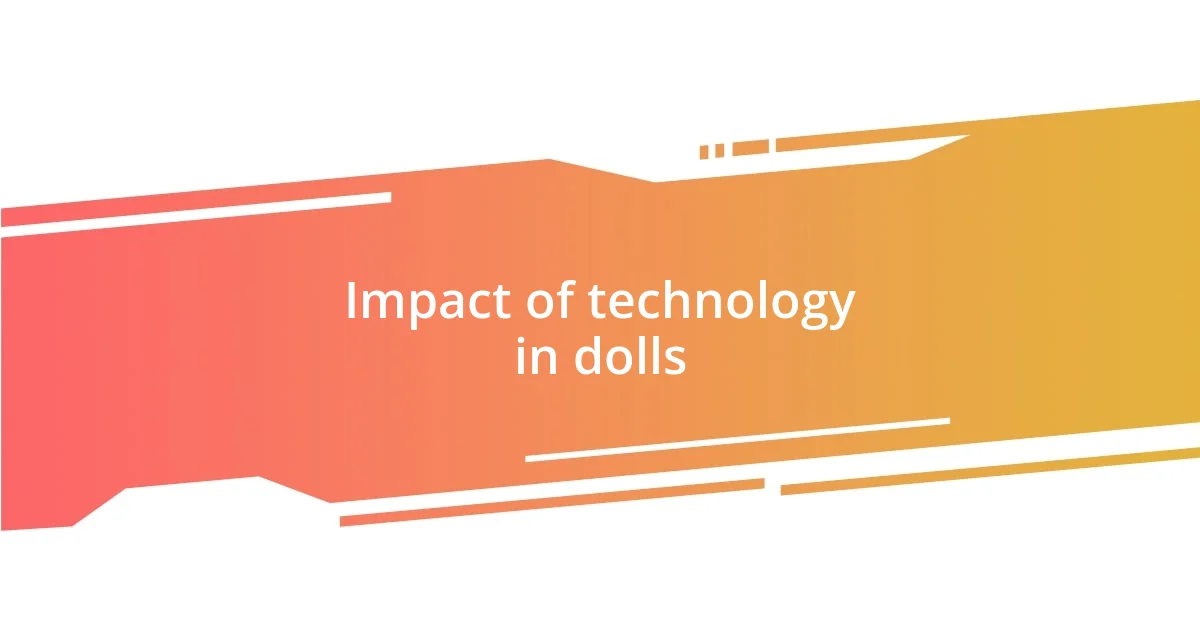
Impact of technology in dolls
The impact of technology on dolls has been nothing short of transformative. These innovations have created a new era where dolls can interact, respond, and even teach children essential skills. I vividly remember when my friend’s child received a robotic doll; the sheer joy on her face when it mimicked her voice was something rare! It made me think about how technology truly connects with emotional play, fostering deeper bonds.
Consider these trends in tech-driven doll advancements:
- Interactive Features: Many dolls can respond to speech, engage in conversations, and even provide personalized learning experiences.
- Coding and STEM Learning: Dolls designed to teach basic coding skills can empower young minds, introducing them to technology at an early age.
- Augmented Reality Experiences: Some dolls offer AR apps that allow kids to explore a virtual world, enhancing imaginative play.
These developments reveal how technology can turn a simple toy into an engaging learning tool, something I wish had existed during my childhood.

Eco-friendly doll production
Eco-friendly doll production is a growing trend that truly resonates with me. I remember visiting a local craft fair and seeing handmade dolls made from organic cotton and recycled materials. The artisans passionately shared their stories about how these dolls were created not just for play, but with a mindfulness towards the environment, echoing the values I hold dear.
One fascinating aspect of this movement is the push for biodegradable materials. Imagine a world where, instead of deteriorating plastic, your child’s beloved doll could break down safely into the earth. I often wonder how powerful it is for children to learn about sustainability through their toys. It transforms playtime into a lesson on caring for our planet, shaping their worldview from an early age.
As brands embrace eco-friendly practices, I’ve noticed a genuine excitement in the community. Participating in a local eco-conscious forum, I found families discussing their joy in supporting brands that prioritize the environment. It’s encouraging to see this shift, combining play with a purpose, and truly reflects our growing responsibility to nurture our planet for future generations.

Exploring customizable doll options
Exploring customizable doll options offers an exciting opportunity for children to express their unique identities. I recall a time when my niece received a customizable doll that she could dress and accessorize according to her mood. Watching her meticulously choose outfits and hairstyles made me realize how such options empower children to explore creativity and individuality in a playful manner.
The ability to create a doll that looks just like them fosters a deeper connection. I remember the joy my daughter felt when we designed her doll’s features to mirror her own, from hair color to eye shape. This personalization not only created a beloved companion but also opened a conversation about self-acceptance and diversity. Isn’t it fascinating how a simple doll can help reflect who we truly are?
Additionally, some companies are enhancing this experience by allowing custom accessories and outfits that tell a story. I once chatted with a parent who shared how their child made a “superhero” doll complete with a cape, showcasing their imagination and aspirations. It’s captivating to see how customizable dolls can spark creative play, encouraging kids to dream big while providing them with a canvas for self-expression.
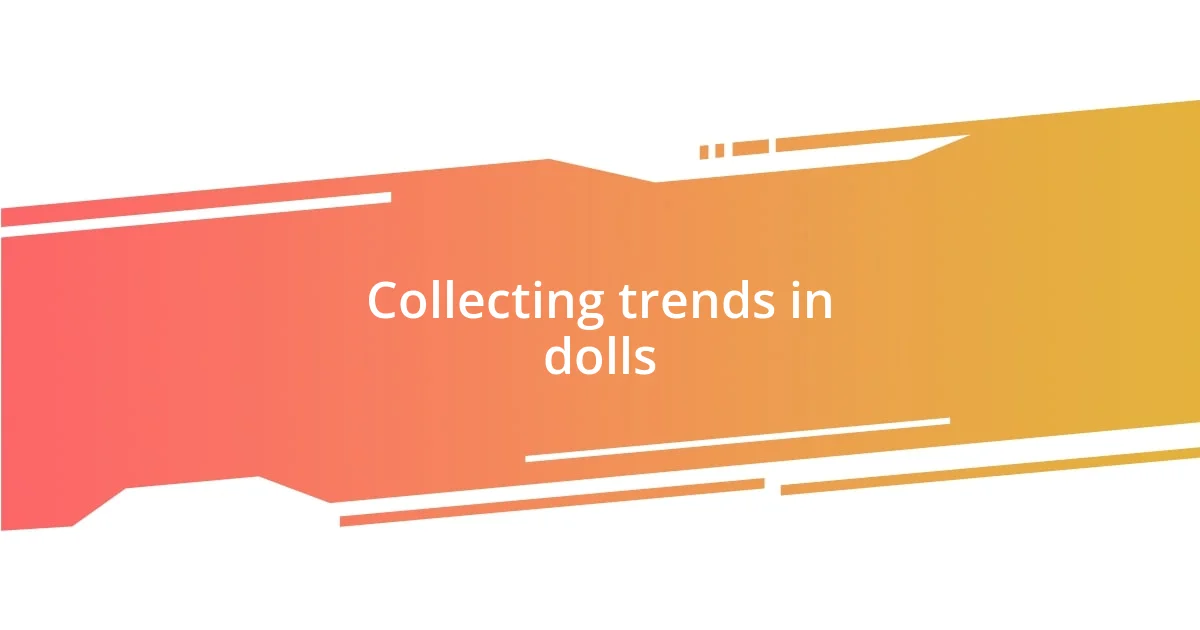
Collecting trends in dolls
Collecting dolls has morphed into a vibrant community that reflects personal stories and shared passions. I remember stumbling upon a local doll collector’s exhibit, brimming with vintage dolls that told tales of different eras. It was intriguing to hear how each doll was not just a toy but a treasured piece of history, often binding collectors through their fond memories and nostalgia. Isn’t it powerful how something seemingly simple can hold such rich narratives?
Another trend I’ve observed is the growing interest in dolls from diverse cultures. During my time at a multicultural fair, I was captivated by a stall featuring dolls that showcased various traditional attire from around the world. It struck me how these dolls serve as a bridge to understanding different cultures, providing children and adults alike with a tangible way to appreciate diversity. This connection goes beyond aesthetics; it’s about building empathy and respect through playful learning.
Then there’s the rise of limited-edition dolls that collectors eagerly pursue. I often find myself visiting online auctions where passionate collectors race to own a doll that could complete their collection. The thrill of the chase is palpable—each bid feels like a step into a larger narrative of artistry and craftsmanship. It makes me ponder, what draws us to these beautifully crafted items? Ultimately, it’s not just about ownership; it’s about belonging to a community that shares the same appreciation for creativity and storytelling.
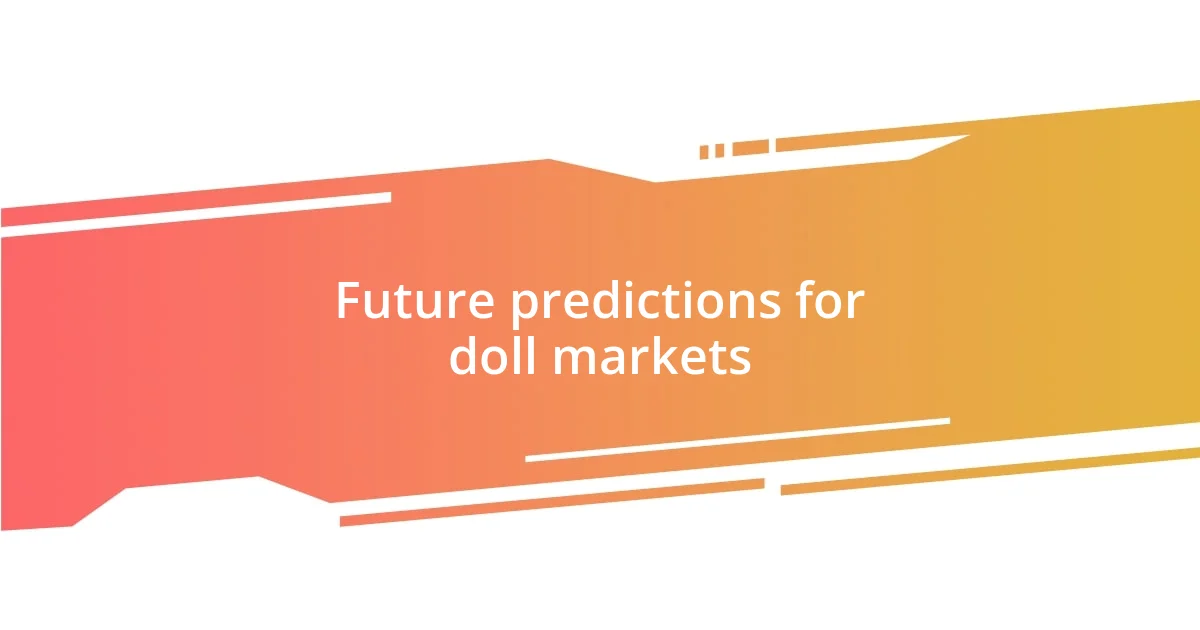
Future predictions for doll markets
Predicting the future of the doll market feels like peering into a crystal ball tinted with creativity and technology. I anticipate that augmented reality (AR) will play a significant role in this evolution, allowing children to interact with their dolls in immersive ways. Imagine a scenario where your child can take their doll on virtual adventures, adding layers of storytelling that blend the real and imagined worlds. Doesn’t it make you excited to think about the possibilities?
I also foresee a heightened emphasis on sustainability in doll production. I had a conversation with a friend recently who expressed concerns about plastic waste. It struck me how many brands are already looking to eco-friendly materials to align with the growing consciousness about environmental impact. This shift not only satisfies consumer demand but also teaches the younger generation about the importance of caring for our planet. How impactful would it be for kids to grow up with dolls that instill eco-friendly values?
Furthermore, as diversity continues to be a driving force in toy selection, I believe that the future will bring even more thoughtful representation. I remember watching a documentary about how children respond to seeing themselves reflected in their toys. It was eye-opening to see how this fosters a sense of belonging and identity. I can’t help but wonder—how will this influence the upbringing of the next generation? The doll market seems poised to embrace this change, helping children understand and appreciate the rich tapestry of humanity through play.

